
James Dennis
James Dennis (senior) was born in Oct 1841 in Osmotherley, Yorkshire, England as the tenth child of Bartholomew Dennis and Jane Milner.
James Dennis was christened on 05 Nov 1841 in Osmotherley, Yorkshire.
In 1851, at the age of nine he was attending the local school and living in the village of Osmotherley, with his parents and siblings. (1851 Census)
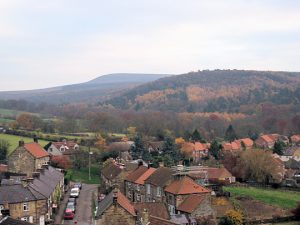
Osmotherley, Yorkshire
In 1861 he resided at 3 Church Street, Osmotherley and his occupation was given as a cartwright apprentice – probably to his father.
When he was 25, he married Elizabeth Banks, (also 25), the daughter of William Banks and Ann Dale, on 6 Aug 1867 in Osmotherley. William was an agricultural labourer at Ampleforth.
James’ occupation is given as a joiner (carpenter).
Three years later, he had made the move 30 kms northeast to South Eston and was living at 30 William Street, at the baptism of son in 1868.
By 1871 he had moved again, this time to Linthorpe, about 6kms away. He was listed in the census as a joiner, living at 45 Adam Street.
Three years later in 1874, he had moved 50kms south to 10 Cleveland Street in nearby Normanby by the time of his daughter Lily’s baptism.
From 1876–1881 he lived at 4 Bulmer St/Row, Normanby and was still working as a wagonwright.
By 1891, 10 years later he had moved back up to Eston – living at 53 Vaughan Street, and was still living there in 1911, where he was working as a waggonwright at the Blast Furnaces, Steelworks. (1891, 1901, 1911 census).
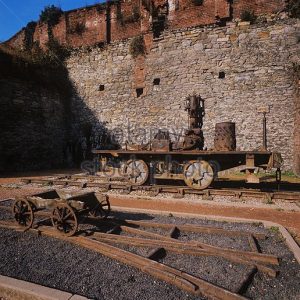
Opened in 1877, the ‘Eston Steelworks’ was the largest, most advanced steel making plant in the world
THE ORIGINS OF ESTON, MIDDLESBOROUGH’S IRON & STEEL
(James Dennis b 1841- d 1916 worked at the Eston Blast Furnace & Steelworks from 1891)
1840 – Prospective iron-makers, Henry Bolckow and John Vaughan take up Joseph Pease’s offer of a green field site at Middlesbrough and build their first rolling mill and foundry.
1841 – The population of Middlesbrough is now 5,463.
1846 – The rising cost of importing Scottish pig iron to Middlesbrough prompts Bolckow & Vaughan to build a blast furnace plant close to supplies of ironstone, limestone and coal at Witton Park in County Durham. The ironstone however soon proves to be inadequate in quality and quantity.
1847 – B & V begin buying ironstone from Grosmont near Whitby. This ore is good quality but supplies are also inadequate and transporting it is a logistical nightmare. It has to be taken by sea, river and rail to Witton Park for smelting and the pig iron is then taken back by rail to Middlesbrough for finishing.
1850 – John Vaughan and mining engineer John Marley (above) strike ‘rusty gold’ in the Eston hills. This saves both the company and Middlesbrough’s economy from disaster and sets Cleveland on course to become the greatest iron-producing centre that the world had ever seen. The Great Iron Rush begins!
1850 – ‘Bold Venture’ is the name given to the first trial quarry at Eston. Between August and December, 4,000 tons is sent by horse’n’cart to Cargo Fleet and then by rail to the Witton Park furnaces.
1851 – (Oct 23rd) Ironstone miner Thomas Smith, 26, becomes the first recorded fatality at Eston mine.
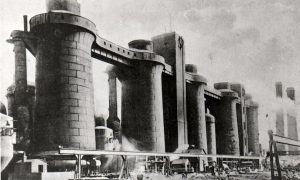
Ironworks Blast furnaces
1851 – The Opening Ceremony of the Mine and Eston Branch Railway brings crowds of villagers to greet B&V and their invited guests arriving on a first class train at Eston. A brass band leads them all up the incline (later known as ‘Old Bank’) to witness the first 6 tubs of ore rolling down.
1852 – New blast furnaces open at B&V’s Ironworks at Vulcan Street as output rockets from Eston.
1854 – B&V open blast furnaces at their Eston Ironworks amid frantic scenes of empire building by other ironmasters setting up along the Tees. Pilgrim workers continue arriving in their thousands for jobs at the mines and works. More and more company streets are hurriedly built to keep pace with insatiable demands.
1868 – There are now around 100 furnaces lining the river between Stockton and Redcar. Middlesbrough is the most famous iron-making town on the planet and is known as ‘Ironopolis’ (the Great City of Iron!).
1872 – ‘Chaloner Pit’ opens on the south side of Eston hills near Guisborough. Within 7 years it will become part of the Eston workings, creating, almost certainly, the largest ironstone mine in the world.
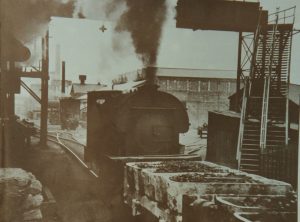
Eston Steelworks
1877 – B.V. open the ‘Eston Steelworks’ the largest and most advanced steel making plant in the world and begin mining suitable ore in Spain. They also employ 2 chemists, Gilchrist and Thomas, to find a way of making steel with Cleveland ironstone.
1879 – Gilchrist and Thomas pioneer a world first at Eston Steelworks. Their process of making steel with phosphoric ironstone saves Cleveland and revolutionises steel-making throughout the world
1885 – The Cleveland Ironstone industry peaks with 40 pits and 10,000 miners yielding over 6 millions tons of ironstone a year. A workforce of 1,600 men and boys produces over a million tons at Eston alone. In a 100 years, the population of Middlesbrough has risen from 25 to 91,302!
1915 – The Eston quarries and drifts along the Eastern escarpment are all but worked out. Also around this time, the entire mining operation is electrified. Steam-powered hauling engines, water pumps and fans such as ‘SS Castle’ are phased out.
1918 – The Cleveland ore-field has been producing a third of the nation’s ironstone for 40 years but the economic downturn that follows WW1 has devastating effects upon the industry and communities. In 1928 the closure of the original Old Bank marks the beginning of the end for mining at Eston.
James Dennis and Elizabeth Banks (married in 1867) had the following children:
- John Banks Dennis was born in 1868 in Normanby, Yorkshire, England. He died in Jan 1870 in Osmotherley aged 2 years old.
- Bartholomew Dennis was born about 1868 in Normanby Yorkshire. He died on 20th October 1923 in Grangetown, Yorkshire. (Age: 55).He married Jane Weston in Oct 1890 in Middlesbrough.
- Jane A Dennis was born about 1870 in Osmotherley, North Yorkshire, England.She died about 1960 in South Bank, Yorkshire.
- James Dennis was born in 1876 in Normanby, Yorkshire, England. He died on 03 Jun 1950 in Southbank, Eston. He married Edith Mary Skelton on 04 Jul 1900 in CofE, South Bank, Middlesborough.
- Ann Elizabeth Dennis was born in 1878 in Normanby, Yorkshire, England.She died in 1975 in South Bank Age: 97).She married Sidney John Charles Lewis on January 1st 1900 in Kirkleatham Church Yorkshire.
- Mary Jane Dennis was born about 1882 in Normanby, Yorkshire, England. She died about 1960 in South Bank Yorkshire (Age: 79).She married James Liddle in Grangetown, Yorkshire.
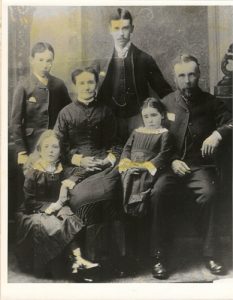
Dennis Family approx 1883 Standing L to R James Dennis Bartholomew Seated L to R Elizabeth Banks Mother James Father Front Ann Elizabeth Mary Jane
James’ wife Elizabeth died in 1900 in Eston, and so when he was 64, James married a Cornish lady of 49 years, Susan Emily Nicholls (daughter of James Nicholls & Mary Jane Phillips) in 1906.
James Dennis and Susan had no children.
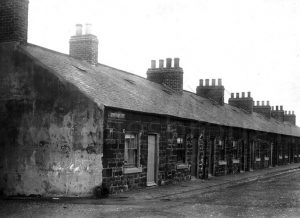
Eston, Yorkshire
James died, aged 74, on 10 Sep 1916 in 85 Burnsville Road, Grangetown, Eston, Yorkshire, England. Susan died the year before, in October 1915 aged 58.
James’ estate was probated on 13 Oct 1916 and probate was granted to his oldest surviving son Bartholomew.

